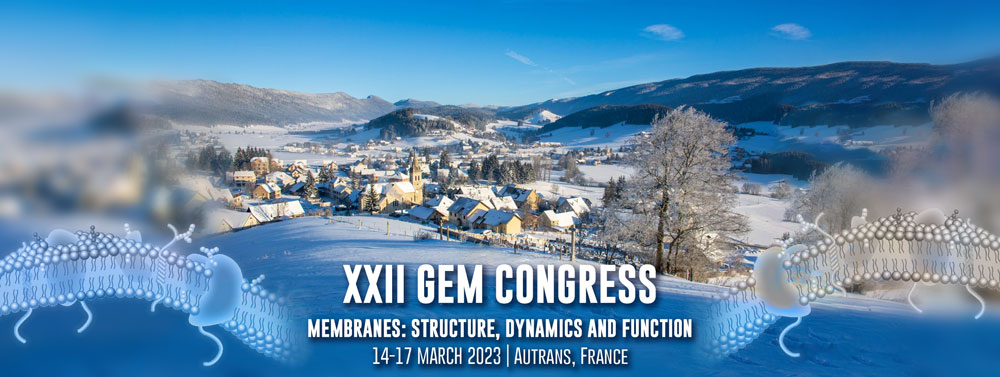Speaker
Description
The Growth Hormone Secretagogue Receptor (GHSR), a 366 amino acids Rhodopsin-like G proteins-coupled receptor (GPCRs), is involved in signal transduction into the cells and plays an important role in food intake, glucose metabolism and immune response. Its high constitutive activity of 50%, seldom among GPCRs, makes this receptor a particularly attractive pharmacological target. In the last two years, the publications of crystal and cryo-electron microscopy structures of GHSR in complexes with different agonists, inverse agonist, or antagonist, and different G-proteins (Shiimura et al. 2020; Wang et al. 2021; Liu et al. 2021; Qin et al. 2022) have expended our structural knowledge of the receptor’s different conformations and binding mechanisms greatly. In parallel, spectroscopic techniques such as solid-state NMR supported the biophysical investigations of the dynamic properties of the uniformly (Schrottke et al. 2017) and site specific (transmembrane domains, loops, C-terminus) (Pacull et al. 2020) 13C-labelled GHSR in a native-like membrane environment. We now aim to investigate the conformational changes of GHSR upon ligand or agonist binding on single residue level. Here, we monitor the changes in the local chemical environment of the three native histidines of GHSR as a variation of their 13C NMR chemical shift using 13C-13C DARR NMR, for the wild type GHSR and for a physiological GHSR mutant lacking its characteristic constitutive activity. Besides providing the necessary low spectral complexity, these three histidines are located in sensitive receptor sites, namely in the helix 6, known to undergo large motion upon ligand binding, and the extracellular loop 2, involved in binding events. The histidines were 13C labelled through an established cell-free expression system where the labeled GHSR is expressed in the precipitated form with a yield of up to 1.5 mg per 1 mL reaction volume and subsequently functionally reconstituted into DMPC bilayer membranes. Three single histidine deficient mutants H186A (Ueda et al. 2011), H258Y and H280Q (Feighner et al. 1998) were designed to allow the assignment of the NMR signals and the well-described A204E mutant (Pantel et al. 2006) was expressed to characterize the effect of the loss of constitutive activity. Upon ghrelin binding, the two helical histidine residues showed characteristic downfield shifts indicative of the structural alterations in the molecule upon outward movement of helix 6. In contrast, upon inverse agonist binding, this response was much weaker suggesting a different binding mechanism. Finally, the shifts for the constitutive activity mutant highlight the existence of an alternative conformation that can be rescued by ghrelin binding.
References:
Feighner SD, Howard AD, Prendergast K, Palyha OC, Hreniuk DL, Nargund R, Underwood D, Tata JR, Dean DC, Tan CP, et al. 1998. Structural requirements for the activation of the human growth hormone secretagogue receptor by peptide and nonpeptide secretagogues. Mol Endocrinol. 12:137–145. eng. doi:10.1210/mend.12.1.0051
Liu H, Sun D, Myasnikov A, Damian M, Baneres J-L, Sun J, Zhang C. 2021. Structural basis of human ghrelin receptor signaling by ghrelin and the synthetic agonist ibutamoren. Nat Commun. 12:6410. eng. doi: 10.1038/s41467-021-26735-5
Pacull EM, Sendker F, Bernhard F, Scheidt HA, Schmidt P, Huster D, Krug U. 2020. Integration of cell-free expression and solid-state NMR to investigate the dynamic properties of different sites of the growth hormone secretagogue receptor. Front. Pharmacol. 11:562113. eng. doi:10.3389/fphar.2020.562113
Pantel J, Legendre M, Cabrol S, Hilal L, Hajaji Y, Morisset S, Nivot S, Vie-Luton M-P, Grouselle D, de Kerdanet M, Kadiri A, Epelbaum J, Le Bouc Y, Amselem S. 2006. Loss of constitutive activity of the growth hormone secretagogue receptor in familial short stature. J Clin Invest. 116(3):760-8. doi: 10.1172/JCI25303.
Qin J, Cai Y, Xu Z, Ming Q, Ji S-Y, Wu C, Zhang H, Mao C, Shen D-D, Hirata K, Ma Y, Yan W, Zhang Y, Shao Z. 2022. Molecular mechanism of agonism and inverse agonism in ghrelin receptor. Nat Commun. 13: 300. eng. doi:10.1038/s41467-022-27975-9
Schrottke S, Kaiser A, Vortmeier G, Els-Heindl S, Worm D, Bosse M, Schmidt P, Scheidt HA, Beck-Sickinger AG, Huster D. 2017. Expression, Functional Characterization, and Solid-State NMR Investigation of the G Protein-Coupled GHS Receptor in Bilayer Membranes. Sci Rep. 7:46128. eng. doi:10.1038/srep46128.
Shiimura Y, Horita S, Hamamoto A, Asada H, Hirata K, Tanaka M, Mori K, Uemura T, Kobayashi T, Iwata So, et al. 2020. Structure of an antagonist-bound ghrelin receptor reveals possible ghrelin recognition mode. Nat Commun. 11:4160. eng. doi:10.1038/s41467-020-17554-1
Ueda T, Matsuura B, Miyake T, Furukawa S, Abe M, Hiasa Y, Onji M. 2011. Mutational analysis of predicted extracellular domains of human growth hormone secretagogue receptor 1a. Regul Pept. 166:28–35. eng. doi:10.1016/j.regpep.2010.08.002
Wang Y, Guo S, Zhuang Y, Yun Y, Xu P, He X, Guo J, Yin W, Xu HE, Xie X, Jiang Y. 2021 Molecular recognition of an acyl-peptide hormone and activation of ghrelin receptor. Nat Commun. 12:5064. eng. doi:10.1038/s41467-021-25364-2
| Session | Structural biology |
|---|

